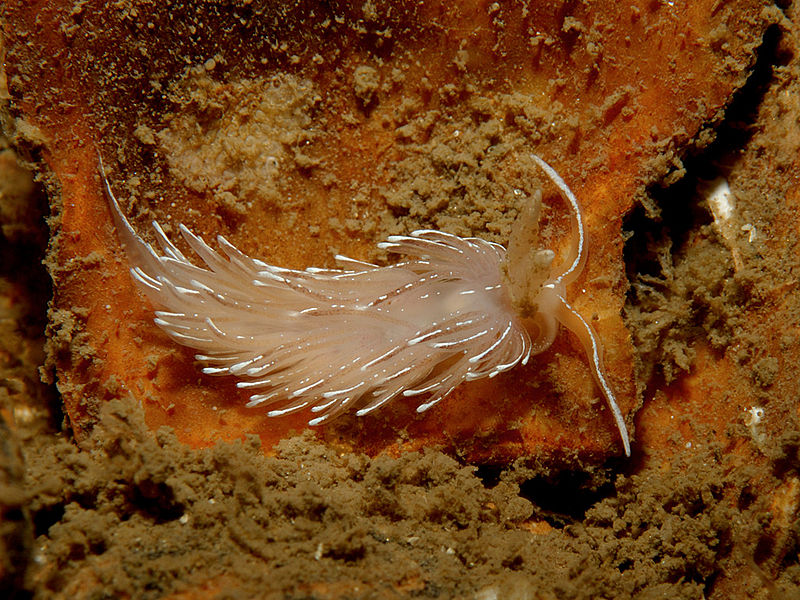Invasion History
First Non-native North American Tidal Record: 2001First Non-native West Coast Tidal Record:
First Non-native East/Gulf Coast Tidal Record: 2001
General Invasion History:
Favorinus blianus is a nudibranch found on rocky shores from the White Sea, Russia to Galicia, Spain (Lemche and Thompson 1974 cited by Thompson and Brown 1984, Hayward and Ryland 1990). In 2001, a specimen was seen by a diver in Narragansett Bay, Rhode Island. There have been no further records of this nudibranch in North American waters (Rudman 2014). This nudibranch feeds on hydroids of the genus Ectopleura and the eggs of other opisthobranchs. It could be transported in hull fouling or in ballast water.
North American Invasion History:
Invasion History on the East Coast:
In June 2001, a diver, Paul Young, photographed an unusual nudibranch off Fort Wetherill State Park, in Jamestown, Rhode Island. William Rudman (Australian Museum) identified the animal and Terence Gosliner agreed with that identification. This is the only known record of this nudibranch in Western Atlantic waters (Rudman 2001-2014).
Description
The body of Favorinus blianus is long and narrow, and tapers towards the bluntly rounded tail. The front corners of the foot form long horns, curved backwards. The oral tentacles are longer than the rhinophores and are about a quarter of the body length. The rhinophores bear three swellings along their length. The rhinophores and oral tentacles are often brown from the base to a varying height, but the tips are white. The cerata are carrot-shaped and smooth, and in up to 7 horseshoe-shaped clusters along the animal's length, increasing in number with its size. The body is whitish but very transparent, and the liver, which varies in color from pinkish to yellowish with brown spots, is visible inside it. The oral tentacles are each marked with a bright opaque white line, which joins to form a single line on the head, extending back as far as the heart. The cerata are each marked with a central line. Individuals can reach 30 mm long. Description based on Thompson and Brown (1984), Hayward and Ryland (1990), and Rudman (2001).
Taxonomy
Taxonomic Tree
| Kingdom: | Animalia | |
| Phylum: | Mollusca | |
| Class: | Gastropoda | |
| Subclass: | Opisthobranchia | |
| Order: | Nudibranchia | |
| Family: | Facelinidae | |
| Genus: | Favorinus | |
| Species: | blianus |
Synonyms
Potentially Misidentified Species
Native to tropical West Atlantic, collected in Chesapeake Bay, but not established.
Favorinus branchialis
Native to Northeast Atlantic.
Ecology
General:
Favorinus blianus is a nudibranch found in lagoons and sheltered marine habitats (Lemche and Thompson 1974; Thompson and Brown 1984, Hayward and Ryland 1990). Nudibranchs are simultaneous hermaphrodites and copulate reciprocally or unilaterally. We do not have information on this animal's egg masses or larval feeding mode. The similar F. branchialis lays its eggs in 'a delicate white spiral', containing up to 20,000 eggs (Thompson and Brown 1984).
Favorinus blianus inhabits rocky shore habitats, down to about 35 m. It is known mostly from cold-temperate habitats, from the White Sea to Galicia, Spain, at marine salinities. A frequent food is the egg masses of other opisthobranchs, which could include the eggs of herbivorous sea slugs (saccoglossans, cephalaspideans, aplysiids) (Lemche and Thompson 1974; Thompson and Brown 1984). In many nudibranchs which feed on cnidarians, the nematocysts (stinging cells) are ingested, and are then incorporated into the cerata, as a defensive mechanism (Barnes 1983).
Food:
Nudibranch eggs; hydroids of Ectopleura spp
Trophic Status:
Carnivore
CarnHabitats
| General Habitat | Rocky | None |
| Salinity Range | Polyhaline | 18-30 PSU |
| Salinity Range | Euhaline | 30-40 PSU |
| Tidal Range | Subtidal | None |
| Vertical Habitat | Epibenthic | None |
Tolerances and Life History Parameters
| Broad Temperature Range | None | Cold temperate-Warm temperate |
| Broad Salinity Range | None | Polyhaline-Euhaline |
General Impacts
Favorinus blianus is not known to be established in North American waters and has no reported impacts.Regional Distribution Map
Non-native
Native
Cryptogenic
Failed
Occurrence Map
References
Barnes, Robert D. (1983) Invertebrate Zoology, Saunders, Philadelphia. Pp. 883Hayward, P.J.; Ryland, J. S. (1990) <missing title>, 2 Clarendon Press, Oxford. Pp. <missing location>
Lemche, A.; Thompson, T. E. (1974) Three opisthobranch mollusks new to the British fauna, Proceedings of the Malacological Society of London 41(3): 185-193
Rudman, W. B. 1997-2016 Sea Slug Forum. http://www.seaslugforum.net/
Thompson, T. E.; Brown, G. H. (1984) <missing title>, Ray Society, London. Pp. <missing location>
